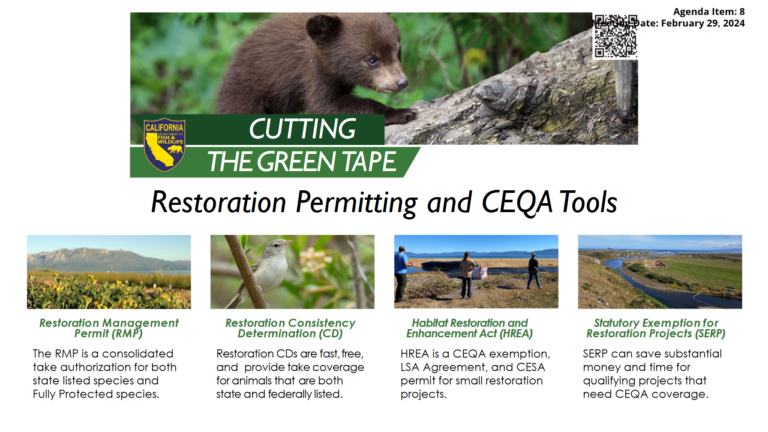The Statutory Exemption for Restoration Projects (SERP), set to expire next year, has facilitated 48 restoration projects totaling over 20,000 acres
California is known for strong laws protecting the environment; however, these policies meant to protect natural resources can unintentionally slow down projects that restore essential habitats and imperiled ecosystems. Recognizing this, the Newsom Administration signed an Executive Order in October 2020 directing state agencies to “implement actions to increase the pace and scale of environmental restoration and land management efforts by streamlining the State’s process to approve and facilitate these projects.” This has become known as the “Cutting the Green Tape Initiative.”
The Cutting the Green Tape Initiative has several permitting and CEQA tools for restoration permitting, including the Restoration Management Permit, Restoration Consistentcy Determination, and the Habitat Restoration and Enchancement Act. In 2021, Governor Newsom added another tool to the toolbox when he signed SB 155, creating a CEQA statutory exemption for restoration projects that meet specific requirements. The provision is set to sunset on January 1, 2025 unless it is renewed by the legislature.
For the Statutory Exemption for Restoration Projects (or SERP) to apply, the project must aim to improve habitat conditions for native fish and wildlife, resulting in long-term net benefits to climate resiliency, biodiversity, and species recovery. The project must also include procedures and ongoing management to protect the environment. The project may have incidental public benefits, such as public access and recreation, but it’s not required. The exemption does not extend to projects that include construction activities unless those construction activities are somehow linked to facilitate the restoration itself.
To apply for the exemption, the lead agency first determines independently that their project meets the criteria and seeks concurrence from the Director of the Department of Fish and Wildlife. The projects are then reviewed, the decision made, and the documents posted on the Department’s website once approved.
Since it is an exemption, there are no requirements for outreach, stakeholder engagement, or engagement with Native American tribes, but it is nonetheless strongly encouraged. Projects in the Delta are further encouraged to engage with the Delta Stewardship Council to ensure the project is consistent with the Delta Plan. Project applicants are also encouraged to use the Good Neighbor Checklists and submit documentation that they have done so.
Since the Statutory Exemption for Restoration Projects Program (SERP) was initiated, 48 projects have benefitted, facilitating the restoration of over 20,000 acres. These projects include wood addition, tidal marsh restoration, fuels reductions, and upland enhancements. On average, feedback suggests that projects are saving about seven months and over $100,000 in CEQA compliance activities that would have otherwise occurred.
The time and money saved could be even more for restoration projects in the Delta. “It’s quite possible […]
Full article: mavensnotebook.com

